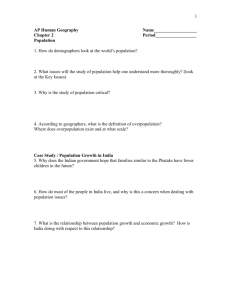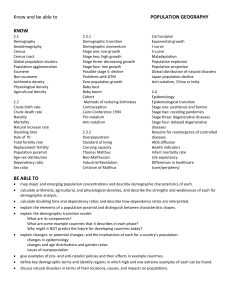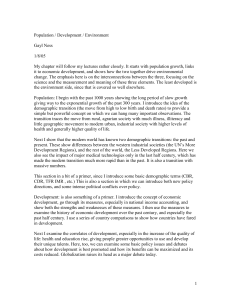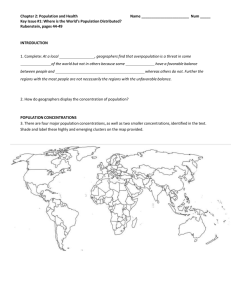File - OCHS History and Geography
advertisement
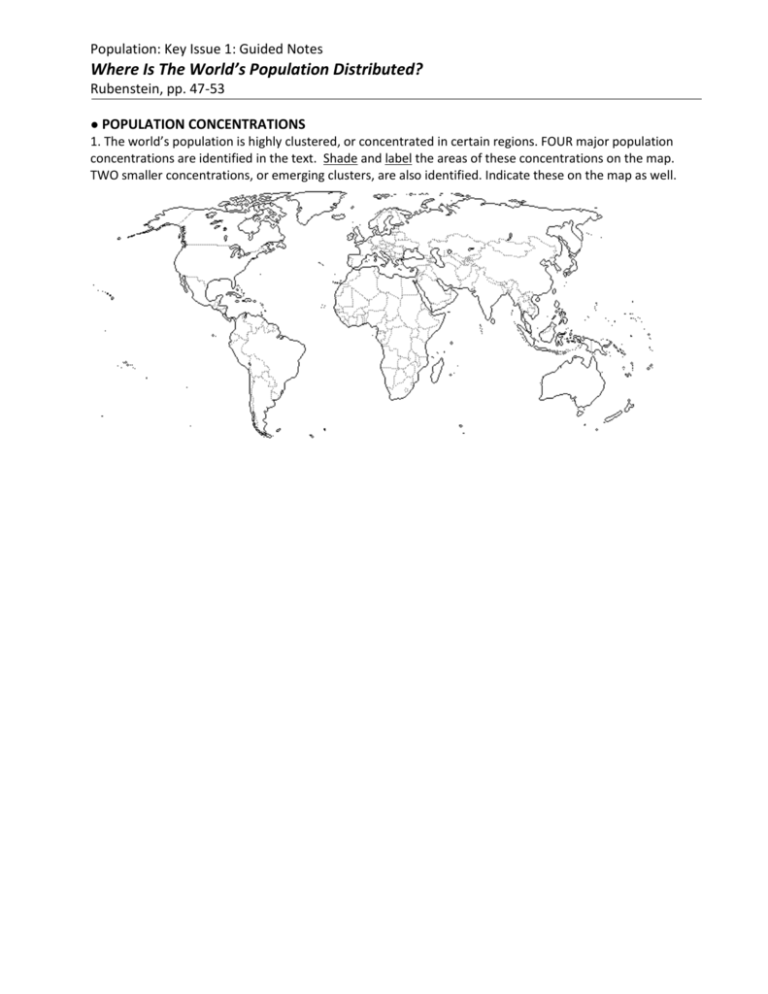
Population: Key Issue 1: Guided Notes Where Is The World’s Population Distributed? Rubenstein, pp. 47-53 ● POPULATION CONCENTRATIONS 1. The world’s population is highly clustered, or concentrated in certain regions. FOUR major population concentrations are identified in the text. Shade and label the areas of these concentrations on the map. TWO smaller concentrations, or emerging clusters, are also identified. Indicate these on the map as well. 2. In the boxes below, make note of several facts, features, countries involved, and characteristics of the four most important population concentrations and two secondary ones. EAST ASIA SOUTHEAST ASIA SOUTH ASIA EUROPE EASTERN NORTH AMERICA WEST AFRICA ● SPARSELY POPULATED REGIONS 3a. Define ecumene: 4a. List the four lands which are sparsely populated on earth in the table below. For each region, briefly explain the reason, which makes it inhospitable for human habitation. Sparsely population land Reason ● POPULATION DENSITY 5. Define each of the following terms on the left side and make some three notes about the type of density on the right side. arithmetic density physiological density agricultural density Population: Key Issue 2 Where Has the World’s Population Increased? Rubenstein, pp. 53-57 ● NATURAL INCREASE 1. Define each of the following: a. crude birth rate (CBR) b. crude death rate (CDR) c. natural increase rate (NIR) 2. What is the NIR today? 3. When did global NIR peak, and what was it? 4. About how many people are being added to the world’s population each year? 5. Define doubling time: 6. In what world regions is most growth occurring? ● FERTILITY 7a. Define total fertility rate (TFR): 7b. What is the global “average” TFR? 8. Complete the chart below to show the regions of global “highs and lows” in TFR. ● MORTALITY Region Europe 9. Define the following: a. infant mortality rate: b. life expectancy 10. How are these mortality rates distributed globally, in terms of the developed and developing worlds? Global “high” Global “low” TFR 6+ Population: Key Issue 3 Why Is Population Increasing at Different Rates in Different Countries? Rubenstein, pp. 57-69 ● THE DEMOGRAPHIC TRANSITION 1. The demographic transition is a___________ with several ____________ and every ________________ is in one of them. 2. Fill in the chart below with 3 characteristics describing each stage in the demographic transition model (CBR, CDR, NIR, etc.). Characterize the amount of growth of each stage (high, low, stable, etc.) Demographic Transition Model STAGE 1 STAGE 2 STAGE 3 STAGE 4 ● POPULATION PYRAMIDS 3. The shape of a pyramid is primarily determined by what demographic rate? 4. What is the dependency ratio? 5. What age groups are categorized as “dependent”? 6. What does the “graying” of a population refer to? 7. What is the sex ratio? 8. What types of countries/regions are likely to have more males than females? ● COUNTRIES IN DIFFERENT STAGES OF DEMOGRAPHIC TRANSITION 9. In the table below, which represents the four stages of demographic transition, identify a characteristic country which is in that stage and briefly describe how it “got there” as described in the textbook. Stages of Demographic Transition: Example countries STAGE 1 STAGE 2 STAGE 3 STAGE 4 ● DEMOGRAPHIC TRANSITION AND WORLD POPULATION GROWTH 11. How many countries are in each of the following stages of the demographic transition? a. Stage 1? b. Stages 2 and 3? c. Stage 4? 12. Identify the two “big breaks” in the demographic transition and their causes. i. the first break ii. the second break 13. In what sense can we say that the first break came to different world regions for different reasons and in different ways? a. it came to Europe and North America… b. it came to Africa, Asia, and Latin America… Population: Key Issue 4 Why Might the World Face an Overpopulation Problem? Rubenstein, pp. 69-76 ● MALTHUS ON OVERPOPULATION 1. Complete the table below to describe the views and theories of various population theorists. Thomas Malthus Neo Malthusians Critics of Malthus ● DECLINING BIRTH RATES 2a. Where was Malthus right? 2b. In what way was Malthus mistaken? 3. What are the only two ways to bring birth rates down? i. ii. 4. What two strategies have proven successful to lower birth rates? i. ii. 5. Take notes on important facts regarding the distribution of contraceptives. ● WORLD HEALTH THREATS 6. What is “epidemiologic transition”? 7. Complete the table below with notes on the stages of epidemiologic transition. Stages 1 and 2 EPIDEMIOLOGIC TRANSITION Stages 3 and 4 Possible Stage 5

